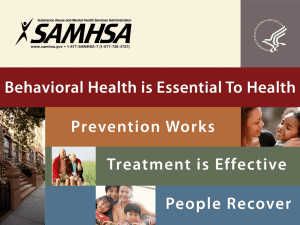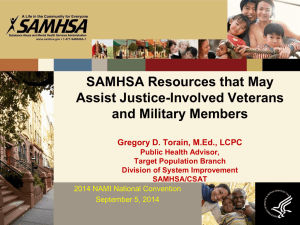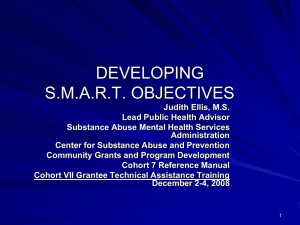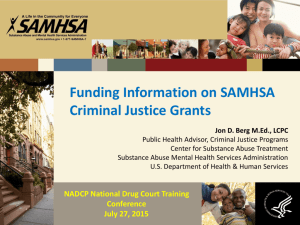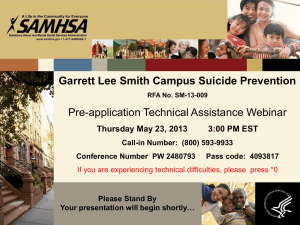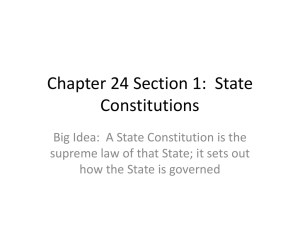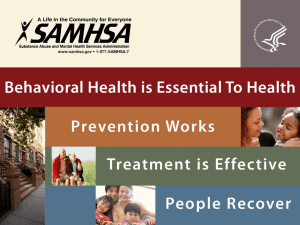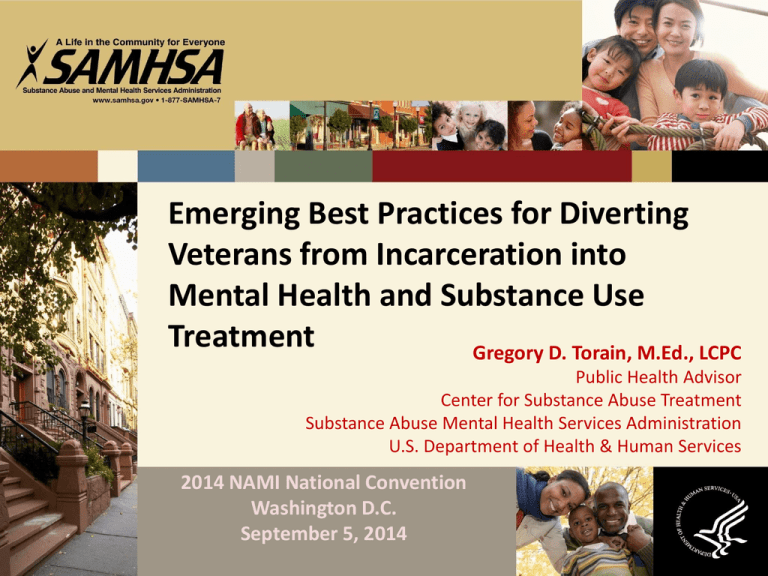
Emerging Best Practices for Diverting
Veterans from Incarceration into
Mental Health and Substance Use
Treatment
Gregory D. Torain, M.Ed., LCPC
Public Health Advisor
Center for Substance Abuse Treatment
Substance Abuse Mental Health Services Administration
U.S. Department of Health & Human Services
2014 NAMI National Convention
Washington D.C.
September 5, 2014
SAMHSA’s Mission
To reduce the impact of substance abuse and
mental illness on America's communities.
• To prevent substance abuse and mental illness
where possible,
• To target effective substance abuse and mental
health services to the people most in need, and
• To translate research more effectively and more
rapidly into the general health care system.
2
SAMHSA’S STRATEGIC INITIATIVES
3
1.
Prevention
2. Trauma
and Justice
3. Military
Families
4. Recovery
Support
5. Health
Reform
6. Health
Information
Technology
7. Data,
Outcomes
& Quality
8. Public
Awareness
& Support
3
Criminal Justice System continues to be the
Largest Referral to Substance Abuse Treatment
School
(Educational),
1.2%
Other Health
Care Provider,
6.4%
Alcohol Drug
Abuse Care
Provider,
9.9%
Individual (inc.
self-referral),
33.1%
Employer/EAP,
0.5%
Other Community
Referral,
12.1%
Court/
Criminal
Justice
Referral/DUI/
DWI,
36.9%
Source: SAMHSA Treatment Data Set (TEDS) Concatenated, 1992-2010
Other recognized legal
entity, or other
Other
DUI/DWI
Prison, 2.4%
Diversionary
program, 2.5%
Probation/
Parole
State/Fed Court,
Other Court
Recognized Legal
Entity
4
20.6%
10.8%
34.6%
29.2%
4
CJ Continuum: Multiple Loci to Address
MH/SUDs & Reduce CJ Contacts
Community (pre-CJC)
Entry
Custody
Diversion
Incarceration
Release/Reentry
Community (post-CJC)
SAMHSA focus areas
Target upstream efforts to
reduce initial CJC
Coordinate efforts
Link resources: Integrate
info & efforts
Incentivize EBPs including
proven medication-based tx
Target downstream efforts
to support recovery &
reduce recidivism
Evaluate & improve
5
Veterans involved in the CJ System
Rand’s “Invisible Wounds of War”
reported 19% of returning
veterans have PTSD, Depression
or both. 2008
Judge Robert Russell
Buffalo, NY Veteran Court
6
Cross-System Partnerships
7
7
Key Elements When Dealing with
Vets-CJ System
• Trauma Informed
• Peer Involved
• Coordinated Across Systems
• Community Services Engaged
Veteran
Trauma
Exposed
Justice
Involved
In Recovery
From BH Condition
8
SAMSHA and Criminal Justice
SAMHSA’s criminal justice grant activities center around
treatment services related to drug courts, offender reentry,
early diversion from jails, early intervention to prevent
deeper systems penetration, community behavioral health
flexibility.
CSAT’s criminal justice budget has expanded in the past few
fiscal years from approximately $23 M to $75 M; even in
present budget cutting mode current budget is $75 M of
which approximately $45 M is committed to treatment - drug
court activities. CMHS’ budget is approximately $5-6 M.
CSAT has committed over $250 M towards grants supporting
the expansion and enhancement of treatment services for
drug court clients.
9
SAMHSA/CSAT Criminal Justice Grant
Programs: Focus on Tx Capacity Expansion
There are approximately 215 active grants in CSAT’s criminal and
juvenile justice portfolio:
115 Adult Drug Court grants including FY 2010, 2011, 2012 SAMHSA
awards and joint grants with BJA adult drug court grant cohorts.
11 Behavioral Health Treatment Court Collaboratives grants.
43 Juvenile/Family Drug Court Grants
• 13 Family Dependency Drug Courts
• 12 Children Affected by Meth-Family Drug Court grants;
• 12 SAMHSA Juvenile Treatment Drug Court grants; and
• 6 SAMHSA/Department of Justice, OJJDP/Robert Wood Johnson “Reclaiming
Futures” Juvenile Drug Court grants.
38 Offender Reentry Program grants
10 Teen Courts
10
SAMHSA Grant Programs – CJ and Vets
Early Diversion from the CJ System (‘13)
Adult, Juvenile, Family Drug Courts (‘13)
Offender Reentry Program
(‘13)
FY 2014
• Behavioral Health Treatment Court
Collaboratives – closed April 18th!
• SAMHSA-BJA Adult Treatment Drug Courts closes May 28!!!
11
FY 2014 Joint Adult Drug Court
Solicitation –TI-14-008
Purpose: Allow applicants to submit a comprehensive
strategy for enhancing drug court services and
capacity and compete for both criminal justice and
substance abuse treatment funds with 1 application.
Due Date: May 28, 2014
Available Funding: Up to $4,500,000 M from BJA;
$4,875,000 from SAMHSA
Number of Awards: 15
Award Amount: Up to $300,000 in BJA; $325,000 in
SAMHSA funds (per yr. for SAMHSA $)
Length of Project Period: Up to 3 years
12
Veterans Courts are Eligible to Apply!!
Eligible drug court models include Tribal
Healing to Wellness Courts, Driving While
Intoxicated (DWI)/Driving Under the
Influence (DUI) Courts, Co-Occurring Drug
and Mental Health Courts, and Veterans
Courts that adhere to the key
components in Defining Drug Courts: The
Key Components
13
Jointly Funded Initiative: SAMHSA and
BJA
Applicants are limited to states or state courts
applying on behalf of a single jurisdiction; local courts;
counties; other units of local government; or federally
recognized Indian tribal governments (as determined
by the Secretary of the Interior). Indian tribal
governments may apply directly or through other
public or not-for-profit private entities. Eligible
jurisdictions must have a fully operational (at least 1
year) adult drug court.
14
Program Goals and Objectives
Overall goal of the Joint Adult Drug Court Solicitation is to expand and/or
enhance the drug court capacity of state, local, and tribal levels to reduce
crime and substance abuse among high risk/high need offenders. This
evidence-based approach includes the key elements of judicially supervised
treatment, drug testing, community supervision, appropriate sanctions, and
recovery support services.
Grant funds must be used to serve high risk/high need populations
diagnosed with substance dependence or addiction to alcohol/other drugs
and identified as needing immediate treatment. Grant funds may be used
to provide services for co-morbid conditions, such as mental health
problems, as long as expenditures remain consistent with the drug court
model which is designed to serve individuals needing treatment for
substance dependence or addiction to alcohol/other drugs.
15
Focus on Clinical/Treatment Services
$ to serve high risk, high need populations
with SA or
CO Disorders;
Expand and/or enhance treatment and recovery
services.
Screen/Assess for Co-Occurring Disorders/Develop Tx
approach for those so identified
MAT-Up to 20% of funds may be used
Encouraged to provide HIV rapid testing ($ up to 5%)
Viral Hepatitis testing (Up to $5000)
Must utilize all available revenue sources first-Payor
of last resort
16
Using Evidence-Based Practices
Grants are intended to fund services/practices that have a
demonstrated evidence based and appropriate to the
population of focus. EBP refers to approaches to treatment
that are validated.
Applicants need to identify the EBP to be implemented
Identify and discuss the evidence that the EBP is effective for
selected population;
If using more than 1 EBP provide a justification and which
modality and population each practice will support; and
Discuss the populations the EBP is effective and how it is
appropriate to your population. Appendix C =info.
17
FY 2013 SAMHSA Treatment Drug Courts”
Funding Off the Shelf in FY 2014
Congress provided
SAMHSA with additional funding in
FY 2014 specifically for treatment services for drug
court clients. As many well scored applications were
not funded in FY 2013 we are reviewing a large number
of these applications with the intention of possibly
funding several of these “off the shelf” applications.
No funding decisions have been made but applicants
were contacted last week so there is a good possibility
that additional applications from Veterans Treatment
Courts will be funded this year!!
18
Veterans Treatment Court
Mentor Court Network
• Free onsite visits for courts and/or individuals to learn
from these courts
• Serve as training and technical assistance sites for 3
years
• Current Mentor Courts:
• Buffalo (NY) Veterans Treatment Court
• Rochester (NY) Veterans Court
• Tulsa (OK) Veterans Treatment Court
• Orange County (CA)
• Funded through a grant from the Center for Substance
Abuse Treatment (CSAT), SAMHSA
• For information, contact NADCP – Carolyn Hardin
19
Want More Information?
CJ Team Contact Information
Ken Robertson, Team Leader, CJ Grants Programs
Kenneth.robertson@samhsa.hhs.gov
240-276-1621
Jon Berg, Public Health Advisor,
Offender Re-entry/Adult Drug Courts
Jon.Berg@samhsa.hhs.gov
240-276-1609
George Samayoa, Public Health Advisor
Drug Courts
George.Samayoa@samhsa.hhs.gov
240-276-1622
Greg Torain, Public Health Advisor
Juvenile Drug Court, Teen Courts, Veterans Treatment Courts
Gregory.Torain@samhsa.hhs.gov
240-276-1832
20
Contacts for SAMHSA Vets-CJ Programs
Center for Mental Health Services Justice
Programs
• David.Morrissette@samhsa.hhs.gov
• 240-276-1912
Center for Substance Abuse Treatment Justice
Programs
• Jon.Berg@samhsa.hhs.gov
• 240-276-1621
21
A Gift for the Audience: Lists of
Resources
SELECTED RESOURCES TO ASSIST
YOU
Contacts
Websites
Programs
Data Information
22


